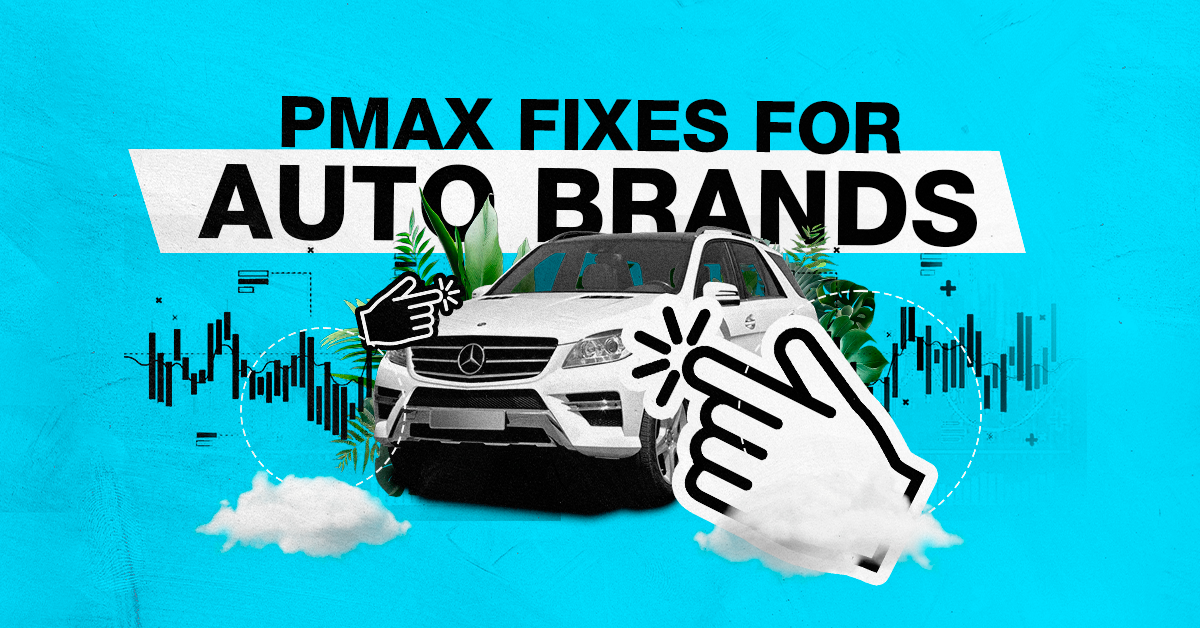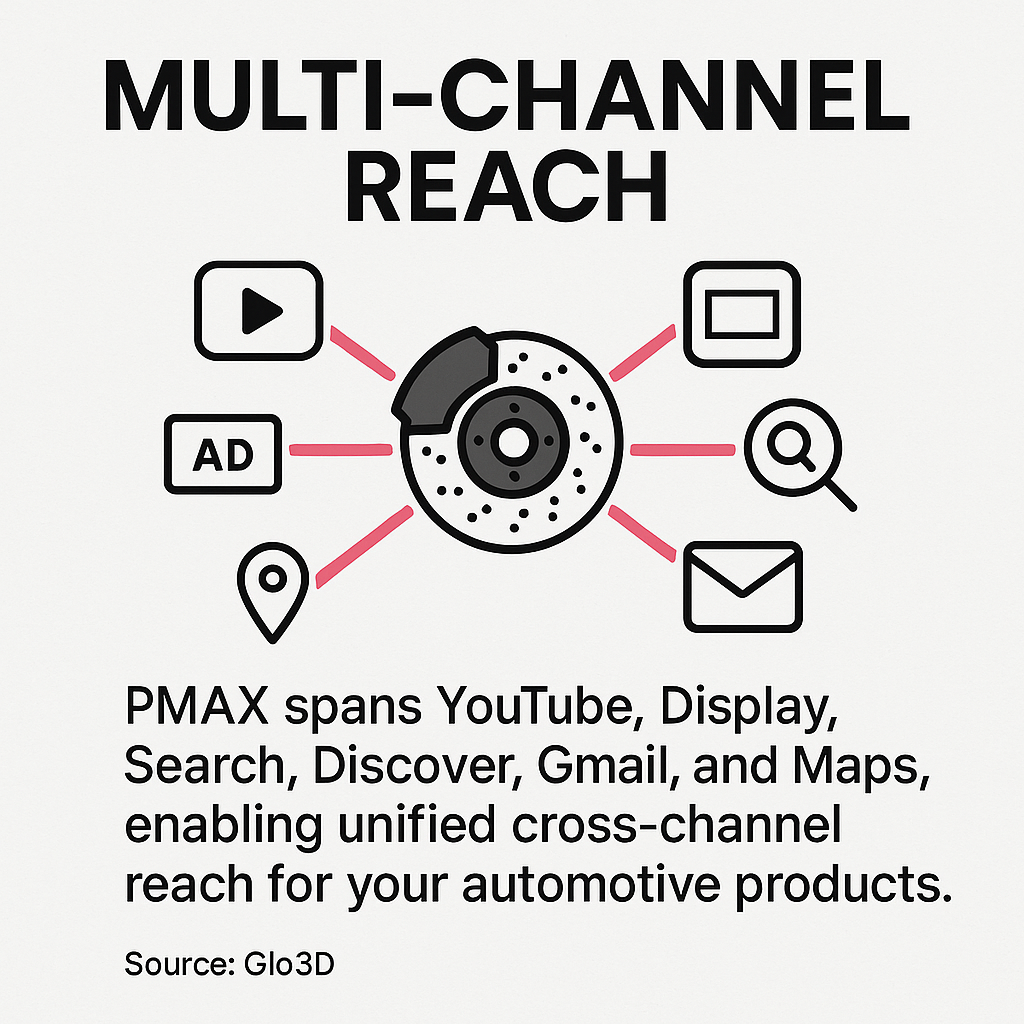
Performance Max campaigns have changed everything for automotive parts retailers. They offer unprecedented reach across Google's entire network while automating much of the optimization process. But with this power comes complexity. Many auto parts advertisers struggle to unlock the full potential of these campaigns.
I've seen countless automotive parts clients make the same PMAX mistakes. Their campaigns underperform despite selling quality products with strong margins. The good news? Most issues have straightforward fixes that can dramatically improve results.
In this guide, I'll walk you through the five most common Performance Max mistakes in the automotive sector. You'll learn exactly how to identify these issues in your own campaigns and implement proven solutions. Let's start fixing your automotive PMAX campaigns today.
Performance Max works differently than traditional campaigns. It uses Google's AI to place your auto parts ads across multiple platforms automatically. This approach removes much of the manual optimization work while expanding your reach significantly.
What makes PMAX especially valuable for automotive parts retailers? The ability to reach customers throughout their buying journey. From initial research to final purchase, your products appear at critical touchpoints.

PMAX spans YouTube, Display, Search, Discover, Gmail, and Maps, enabling unified cross-channel reach for your automotive products. (Source: Glo3D)
This multi-channel approach perfectly matches how today's auto parts customers shop. They research on YouTube, browse on Display networks, search specific part numbers, discover options through Google's feeds, and even look for local availability on Maps.
|
PMAX Channel
|
Relevance to Auto Parts Shoppers
|
Typical Customer Activity
|
|---|---|---|
|
YouTube
|
High
|
Watching installation tutorials, product reviews
|
|
Search
|
Very High
|
Looking for specific parts by name/number
|
|
Display
|
Medium
|
Browsing automotive content, researching
|
|
Gmail
|
Low-Medium
|
Receiving order confirmations, promotions
|
|
Maps
|
Medium-High
|
Finding local availability for urgent needs
|
This comprehensive channel coverage explains why proper PMAX implementation matters so much for auto parts sellers. Now let's examine the most common mistakes and their solutions.
The first major mistake I see automotive advertisers make? Failing to recognize just how cost-efficient PMAX can be compared to standard search campaigns. This oversight leads to underinvestment in a potentially transformative ad format.
The cost difference is substantial. The median CPM for auto parts in PMAX campaigns ranges from $8.46 to $15.52, while traditional Search Ads CPM ranges from $55.37 to $210.23.
This dramatic cost advantage means you could potentially reach 5-10 times more potential customers with the same budget. For auto parts retailers with tight margins, this efficiency creates significant competitive advantages.
|
Campaign Type
|
Median CPM (Cost Per 1000 Impressions)
|
Potential Reach with $1,000 Budget
|
Efficiency |
|---|---|---|---|
|
PMAX
|
$8.46-$15.52
|
64,000-118,000 impressions
|
5-10× higher
|
|
Search Ads
|
$55.37-$210.23
|
4,700-18,000 impressions
|
Baseline
|
The solution starts with proper budget allocation. Many auto parts retailers should shift a larger percentage of their ad spend to PMAX campaigns. However, this doesn't mean abandoning traditional search entirely.
The ideal approach combines both campaign types. Use strategic PPC planning to determine how much budget to allocate to each. Typically, I recommend automotive clients start with a 70/30 split favoring PMAX, then adjust based on performance data.
Monitor your comparative metrics closely. Track cost-per-acquisition across both campaign types for the same products. This data-driven approach reveals the true efficiency gap for your specific parts catalog.
The second critical mistake involves improper PMAX campaign structure. Many auto parts retailers create overly broad campaigns containing wildly different product categories. This approach confuses Google's AI and dilutes performance.
What makes proper structure so important for automotive? The extreme specificity of parts searching. A customer looking for a "2015 Honda Civic front brake rotor" has very different intent than someone searching for "universal floor mats."
|
Common Structural Mistake
|
Impact on PMAX Performance
|
Recommended Solution
|
|---|---|---|
|
Mixing vehicle-specific and universal parts
|
Diluted audience signals, confused bidding
|
Create separate campaigns by specificity level
|
|
Combining high and low-margin parts
|
Inadequate budget for valuable conversions
|
Separate campaigns by profit margin tiers
|
|
Including both fast and slow-moving inventory
|
Skewed performance metrics, targeting issues
|
Segment by sales velocity, adjust bidding accordingly
|
|
Mixing different vehicle types (cars vs. trucks)
|
Imprecise audience targeting, relevance issues
|
Create vehicle-type specific campaigns
|
The solution requires thoughtful segmentation. Structure your automotive PMAX campaigns around clear product categories with similar characteristics. How should you organize your campaigns for maximum effectiveness?
Create separate campaigns for:
This structured approach allows Google's algorithm to develop more precise bidding strategies for each product category. It also enables you to allocate budget based on strategic priorities and profit margins.
Additionally, use the asset group feature within each campaign to further refine your structure. Group similar products together to create more relevant ad experiences for potential customers.
The third major mistake involves poor conversion tracking implementation. Many automotive parts retailers fail to properly track the full customer journey, missing critical optimization opportunities.

This oversight proves particularly costly in the automotive sector. Combining Vehicle Listing Ads (VLAs) with offline conversion tracking drives over 20% higher dealership store visits, demonstrating the power of comprehensive tracking. (Source: Wired Media)
While this statistic focuses on dealerships, it highlights a critical truth for parts retailers too: better tracking leads to better performance. Many parts customers research online but complete purchases in person or over the phone.
Essential conversion tracking elements for automotive PMAX include:
The solution requires implementing comprehensive tracking that captures all conversion types. Start by using advanced call tracking solutions to attribute phone orders back to your PMAX campaigns.
Next, implement enhanced conversions to improve tracking accuracy. This feature uses hashed first-party data to better connect ad interactions to purchases, even when cookies are limited.
For retailers with physical locations, consider implementing store visit tracking. This helps attribute in-store purchases back to your online advertising efforts, completing the attribution picture.
Finally, ensure you're tracking actual order values, not just conversion counts. This value-based approach helps Google's AI optimize toward your most profitable parts and customers.
The fourth mistake involves poor asset optimization. Many automotive parts retailers use generic product images and descriptions that fail to stand out in competitive ad placements.
This issue matters tremendously in the visually-driven parts market. Automotive shoppers need to see detailed, accurate images of parts to ensure compatibility with their specific vehicles.
|
Asset Type
|
Common Mistakes
|
Best Practices
|
|---|---|---|
|
Product Images
|
Generic stock photos, poor lighting, single angles |
Multiple angles, in-vehicle context, comparative sizing
|
|
Headlines
|
Vague descriptions, missing specifications |
Include make/model compatibility, key specifications
|
|
Descriptions
|
Technical jargon, feature-focused
|
Benefit-oriented, compatibility information
|
|
Videos
|
Missing entirely or poor quality
|
Installation tutorials, 360° views, comparison videos
|
Our clients at a performance cooling manufacturer saw a 55% increase in revenue when they implemented comprehensive asset optimization across their product line.
The solution starts with high-quality product imagery. For automotive parts, this means:
Next, optimize your headlines and descriptions. Include specific vehicle compatibility information directly in headlines when possible. Focus descriptions on benefits rather than just technical specifications.
Video assets prove particularly effective for auto parts. Create installation tutorials, 360° product views, and comparison videos showing your parts alongside competitors. These assets dramatically improve engagement rates.
Finally, maintain consistent branding across all assets. This builds trust with automotive customers who often make repeated purchases over time.
The fifth critical mistake involves failing to properly analyze and act on performance data. Many automotive advertisers set up their PMAX campaigns but then neglect the ongoing optimization process.

This oversight means missing significant improvement opportunities. A PMAX campaign for a financial services provider achieved a 22% increase in conversions and 20% decrease in CPA through proper optimization. In another case, a cross-country campaign achieved a 90% decrease in CPC by focusing on low-penetration markets. (Source: My Codeless Website)
While these examples come from other industries, they illustrate the massive performance gains possible through proper PMAX optimization. Automotive parts retailers can achieve similar or better results due to the highly specific nature of parts searching.
|
Key Performance Metric
|
What It Reveals
|
Optimization Action
|
|---|---|---|
|
Conversion Rate by Asset Group
|
Which product categories perform best
|
Reallocate budget to high-converting groups
|
|
Click-Through Rate by Network
|
Where your ads resonate most
|
Optimize assets for top-performing networks
|
|
New vs. Returning Customer Conversion
|
Audience familiarity impact
|
Adjust bidding strategy for customer segments
|
|
Mobile vs. Desktop Performance
|
Device preference among your customers
|
Tailor assets and bidding for preferred devices
|
The solution involves establishing a regular analysis cadence. Review your PMAX performance weekly, but make major adjustments only after collecting 2-4 weeks of data. This balanced approach prevents reactionary changes while ensuring timely optimization.
Focus on these top performance indicators:
Use insights to make targeted bidding adjustments rather than wholesale campaign changes. Increase investment in high-performing segments while testing improvements for underperforming ones.
Consider implementing a weekly optimization checklist that includes reviewing new search terms, analyzing performance across networks, checking listing quality, and reviewing asset effectiveness ratings. This systematic approach turns performance data into actionable improvements.

Avoiding these five common PMAX mistakes can transform your automotive parts advertising performance. The solutions aren't complicated, but they do require attention to detail and consistent implementation.
Remember, Performance Max offers unprecedented opportunities for auto parts retailers. The cost efficiency alone makes it worth mastering, with potential CPM savings of 70-90% compared to traditional search campaigns.
To quickly improve your campaigns, focus on these key fixes:
Want to discuss your specific automotive PMAX challenges? Our team specializes in optimizing Performance Max campaigns for auto parts retailers. We'd be happy to review your current setup and suggest targeted improvements.
Get in touch today to discover how we can help you avoid these common mistakes and maximize your automotive PMAX performance.
Our customers value boutique agency approach with access to a seasoned team, profit-based goals, and clear communication.



